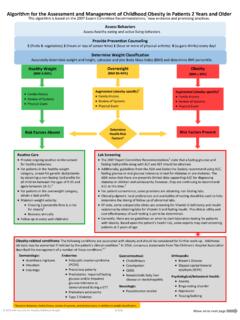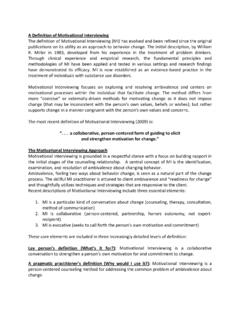Transcription of SFBT Treatment Manual - HSD
1 1 Solution Focused Therapy Treatment Manual for Working with Individuals Research Committee of the Solution Focused Brief Therapy Association 2010 Terry S. Trepper Eric E. McCollum Peter De Jong Harry Korman Wallace Gingerich Cynthia Franklin The purpose of this Preliminary Treatment Manual is to offer an overview to the general structure of Solution-Focused Brief Therapy ( sfbt ). This Manual will follow the standardized format and include each of the components recommended by Carroll and Nuro (1997). The following sections are included: (a) overview, description and rationale of sfbt ; (b) goals and goal setting in sfbt ; (c) how sfbt is contrasted with other treatments; (d) specific active ingredients and therapist behaviors in sfbt ; (e) nature of the client-therapist relationship in sfbt ; (f) format; (g) session format and content; (g) compatibility with adjunctive therapies; (h) target population; (i) meeting needs of special populations; (j) therapist characteristics and requirements; (j) therapist training; and (k) supervision.
2 OVERVIEW, DESCRIPTION, AND RATIONALE Solution-Focused Brief Therapy group Treatment is based on over twenty years of theoretical development, clinical practice, and empirical research ( , de Shazer et al.,1986; Berg & Miller, 1992; Berg, 1994; De Jong & Berg (2008); de Shazer, Dolan et al., 2006). Solution-Focused Brief Therapy is different in many ways from traditional approaches to Treatment . It is a competency-based model, which minimizes emphasis on past failings and problems, and instead focuses on clients strengths and previous successes. There is a focus on working from the client s understandings of her/his concern/situation and what the client might want different.
3 The basic tenets that inform Solution-Focus Brief Therapy are as follows: It is based on solution-building rather than problem-solving. The therapeutic focus should be on the client s desired future rather than on past problems or current conflicts. Clients are encouraged to increase the frequency of current useful behaviors No problem happens all the time. There are exceptions that is, times when the problem could have happened but didn t that can be used by the client and therapist to co-construct solutions. 2 Therapists help clients find alternatives to current undesired patterns of behavior, cognition, and interaction that are within the clients repertoire or can be co-constructed by therapists and clients as such.
4 Differing from skill-building and behavior therapy interventions, the model assumes that solution behaviors already exist for clients. It is asserted that small increments of change lead to large increments of change . Clients solutions are not necessarily directly related to any identified problem by either the client or the therapist. The conversational skills required of the therapist to invite the client to build solutions are different from those needed to diagnose and treat client problems. Solution-Focused Brief Therapy differs from traditional Treatment in that traditional Treatment focuses on exploring problematic feelings, cognitions, behaviors, and/or interaction, providing interpretations, confrontation, and client education (Corey, 1985).
5 In contrast, sfbt helps clients develop a desired vision of the future wherein the problem is solved, and explore and amplify related client exceptions, strengths, and resources to co-construct a client-specific pathway to making the vision a reality. Thus each client finds his or her own way to a solution based on his or her emerging definitions of goals, strategies, strengths, and resources. Even in cases where the client comes to use outside resources to create solutions, it is the client who takes the lead in defining the nature of those resources and how they would be useful. Solution-Focused Therapeutic Process sfbt utilizes the same process regardless of the concern that the individual client brings to therapy.
6 sfbt is an approach that focuses on how clients change , rather than one which focuses on diagnosing and treating problems. As such, it uses a language of change . The signature questions used in solution-focused interviews are intended to set up a therapeutic process wherein practitioners listen for and absorb clients words and meanings (regarding what is important to clients, what they want, and related successes), then formulate and ask the next question by connecting to clients key words and phrases. Therapists then continue to listen and absorb as clients again answer from their frames of reference, and once again formulate and ask the next question by similarly connecting to the client s responses.
7 It is through this continuing process of listening, absorbing, connecting, and client responding that practitioners and clients together co-construct new and altered meanings that build toward solutions. Communication researchers McGee, Del Vento, and Bavelas (2005) describe this process as creating new common ground between practitioner and client in which questions that contain embedded assumptions of client competence and expertise set in motion a conversation in which clients participate in discovering and constructing themselves as persons of ability with positive qualities that are in the process of creating a more satisfying life.
8 Examples of this therapeutic process are given below when the questions used in sfbt are presented. General Ingredients of Solution Focused Brief Therapy Most psychotherapy, sfbt included, consists of conversations. In sfbt there are three main general ingredients to these conversations. 3 First, there are the overall topics. sfbt conversations are centered on client concerns; who and what are important to the clients; a vision of a preferred future; clients exceptions, strengths, and resources related to that vision; scaling of clients motivational level and confidence in finding solutions; and ongoing scaling of clients progress toward reaching the preferred future.
9 Second, as indicated in the previous section, SF conversations involve a therapeutic process of co-constructing altered or new meanings in clients. This process is set in motion largely by therapists asking SF questions about the topics of conversation identified in the previous paragraph and connecting to and building from the resulting meanings expressed by clients. Third, therapists use a number of specific responding and questioning techniques that invite clients to co-construct a vision of a preferred future and draw on their past successes, strengths, and resources to make that vision a reality. GOAL SETTING AND SUBSEQUENT THERAPY The setting of specific, concrete, and realistic goals is an important component of sfbt .
10 Goals1 are formulated and amplified through SF conversation about what clients want different in the future. Consequently, in sfbt , clients set the goals. Once a beginning formulation is in place, therapy focuses on exceptions related to goals, regularly scaling how close clients are to their goals or a solution, and co-constructing useful next steps to reaching their preferred futures. HOW sfbt IS CONTRASTED WITH OTHER TREATMENTS sfbt is most similar to competency-based, resiliency-oriented models, such as some of the components of motivational enhancement interviewing (Miller & Rollnick, 2002; Miller, Zweben, DiClemente, & Rychtarik, 1994).



